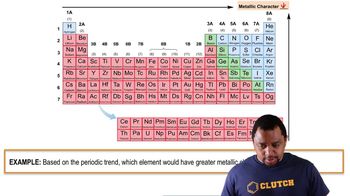Here are the essential concepts you must grasp in order to answer the question correctly.
Metallic Character
Metallic character refers to the set of properties typically associated with metals, including conductivity, malleability, ductility, and luster. Elements with high metallic character tend to lose electrons easily, forming positive ions. This property is influenced by an element's position in the periodic table, which affects its atomic structure and behavior.
Recommended video:
Metallic Character Example
Periodic Trends
Periodic trends are predictable patterns observed in the periodic table, such as atomic radius, ionization energy, and electronegativity. As one moves from left to right across a period, elements generally become less metallic due to increasing nuclear charge, which attracts electrons more strongly. Conversely, moving down a group, atomic size increases, often leading to a greater metallic character.
Recommended video:
Effective Nuclear Charge
Effective nuclear charge (Z_eff) is the net positive charge experienced by an electron in a multi-electron atom. It accounts for the shielding effect of inner electrons, which reduces the full nuclear charge felt by outer electrons. As Z_eff increases across a period, the attraction between the nucleus and valence electrons strengthens, leading to a decrease in metallic character.
Recommended video:




